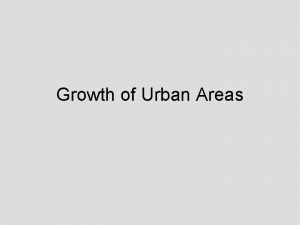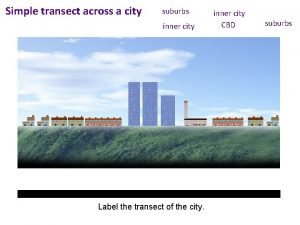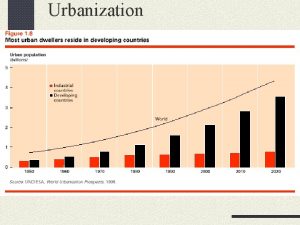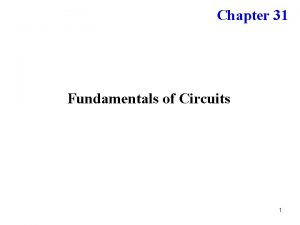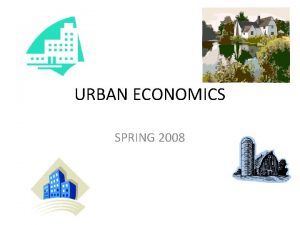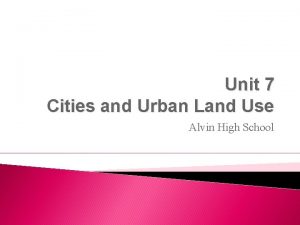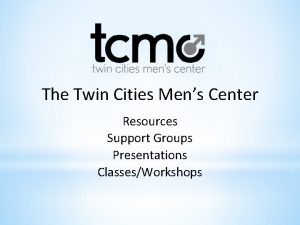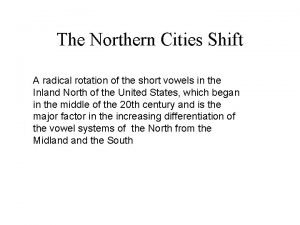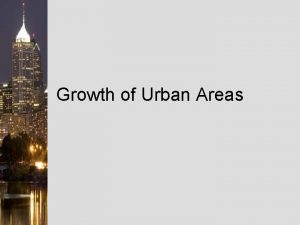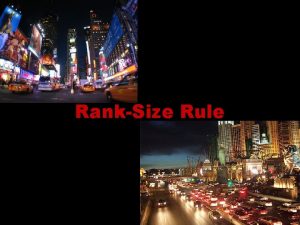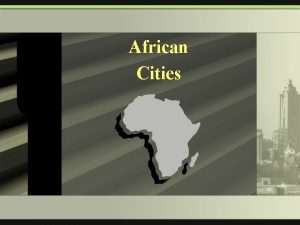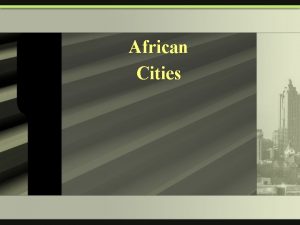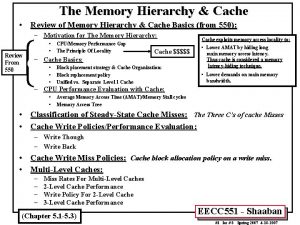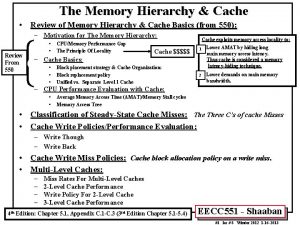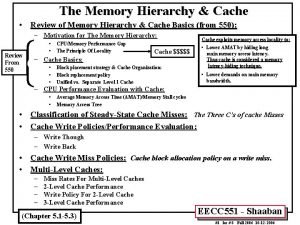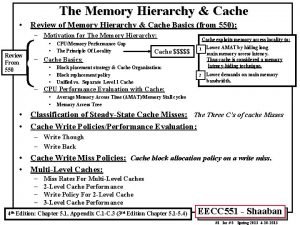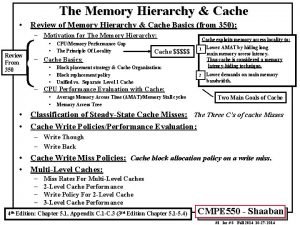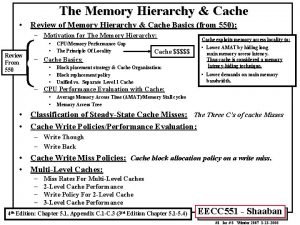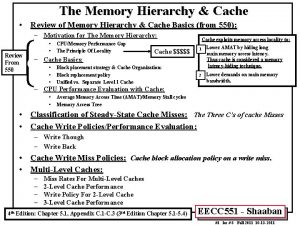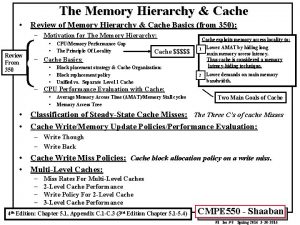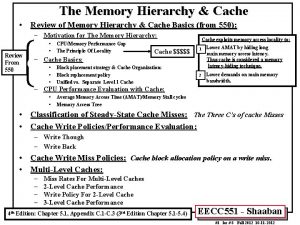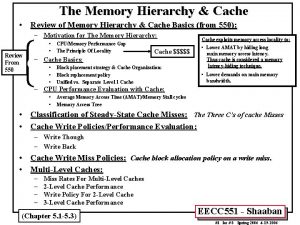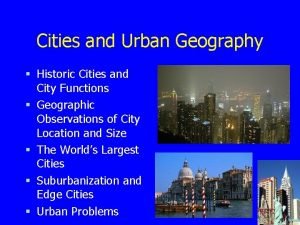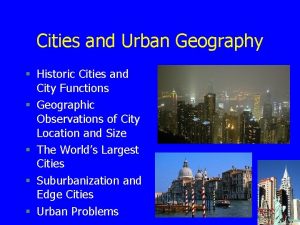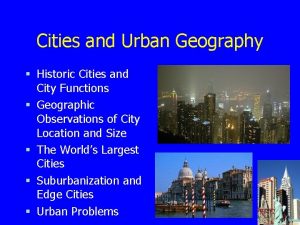RankSize Rule City Hierarchy Review System of cities
















































- Slides: 48

Rank-Size Rule

City Hierarchy Review *System of cities with various levels *Few cities at top level Increasing number of settlements at each lower level *Larger cities provide more services than smaller towns – exists at regional, national, and global scales Number of Business Types by Population of Colorado Cities (1899) Graph from Kuby, HGIA

“World cities are not simply the world’s largest … cities. Rather, they are the control centers for the global economy, places where critical decision making and interaction take place with regard to global economic, cultural, and political issues” (Knox and Marston 2001, p. 426). “WORLD CITIES”


Business Services and Settlements • World cities – Ancient world cities – Medieval world cities – Modern world cities • Hierarchy of business services – World cities – Command control centers – Specialized producer-service centers – Dependent centers • Economic base of

Rank-Size Distribution of Cities Fig. 12 -9: Cities in the U. S. follow the rank-size distribution relatively closely, as indicated by the almost straight line on this log scale. In Romania, there are few settlements in two size ranges.

Modern World Cities • In modern times several world cities have emerged where a high percentage of the world’s business is transacted and political power is concentrated. • These world cities are centers of business services, but they stand at the top of the central place hierarchy in the provision of consumer services, and many also serve as publicservice centers. • Where do you think today’s most influential three world cities are?

Hierarchy of World Cities Fig. 12 -14: London, New York, and Tokyo are the dominant world cities in the global economy. Other major and secondary world cities play lesser roles.

Command Control Centers • The second level of cities—command control centers—contains the headquarters of many large corporations, concentrations of business services, educational, medical, and public institutions. • Two levels of command control centers can be identified: regional centers and subregional centers. • In the United States, examples of regional command centers are Atlanta and Kansas City. • Examples of sub-regional centers are Biloxi and Oklahoma City.

Specialized Producer-Service Centers • The third level of cities – specialized producer-service centers – offers a more narrow and highly specialized variety of services. • One group of these cities specializes in the management and research/development activities related to specific industries. • A second group specializes as centers of government and education, notably state capitals that also have a major university.

Dependent Centers • The fourth-level cities, dependent centers, provide relatively unskilled jobs and depend for their economic health on decisions made in the world cities, regional command control centers, and specialized producer-service centers. • Four subtypes of dependent centers can be identified in the United States: resort, retirement, and residential centers; manufacturing centers; industrial and military centers; mining and industrial centers.

Economic Base of Settlements • A settlement’s distinctive economic structure derives from its basic industries, which export primarily to consumers outside the settlement. • Non-basic industries are enterprises whose customers live in the same community, essentially consumer services. • A community’s unique collection of basic industries defines its economic base. • A community’s basic industries identified by computing percentage of the community’s workers employed in different types of businesses. • If the percentage is much higher in the local community, (compared to the country), then that type of business is a basic economic activity. the can be

Rank-Size Rule: • Relatively developed societies produce a pattern in the size of their cities according to a mathematical formula.

Rank-size Rule ●Rank Size Rule o Nth largest city of a national system will be 1/n the size of the largest city. o Example - US is close to this model - not a good model for newly urbanized countries ie LDC

Rank Size Rule Example: 1. 2. 3. 4. 5. Largest City 2 nd largest City 3 rd Largest City 4 th Largest City 5 th Largest City 1, 000 500, 000 333, 333 250, 000 ?

Rank Size Rule Example: 1. 2. 3. 4. 5. Largest City 2 nd largest City 3 rd Largest City 4 th Largest City 5 th Largest City 1, 000(1/1) 500, 000 (1/2) 333, 333 (1/3) 250, 000 (1/4) 200, 000 (1/5)

practice • If a country conforms to Rank Size Rule, fill in the population chart below: 1. City A 250, 000 2. City B ? 3. City C ? 4. City D ? 5. City E ?

Practice • If a country conforms to Rank Size Rule, fill in the population chart below: 1. City A 250, 000 2. City B 125, 000 3. City C 83, 333 4. City D 62, 500 5. City E 50, 000

“Ideal” line

How Well does the USA fit? 1. New York City, NY 2. Los Angeles, CA 3. Chicago, IL 4. Houston, TX 5. Philadelphia, PA 6. Phoenix , AZ 7. San Antonio, TX 8. San Diego, CA 9. Dallas, TX 10. San Jose, CA 8. 4 m

How Well does the USA fit? 1. New York City, NY 2. Los Angeles, CA 3. Chicago, IL 4. Houston, TX 5. Philadelphia, PA 6. Phoenix , AZ 7. San Antonio, TX 8. San Diego, CA 9. Dallas, TX 10. San Jose, CA 8. 4 m 3. 8 m 2. 7 m 2. 1 m 1. 5 m 1. 4 m 1. 2 m 1. 3 m 1. 1 m 945, 000

U. S. Line - 2007

How does the U. S. Compare?

Why do we care? - Interesting math! - Countries that have good rank-size distribution improve the quality of life of their citizens. A regular hierarchy (USA) indicates that a society is wealthy enough to provide services for its people. - Absence of rank-size means people may struggle to access large urban settlements, thus high level services like hospitals.

PRIMATE CITIES • In less developed countries/regions the largest city is overly large. The pattern of settlements is such that the largest settlement has more than twice as many people as the second largest settlement and is more than twice as significant. • There is usually not an obvious 2 nd city – Example Pairs France 8. 7 million, next city Marseille-1. 2 million

Factors Encouraging Primacy • Favorable initial advantages for site • Advantages maintained and enhanced • Magnetic attraction for businesses, services and people (cumulative effect) • Disproportionate growth increases attractiveness • Has a parasitic effect, sucking wealth, natural and human resources. • They attract overseas investment and benefits that will eventually benefit the whole country

What advantages do primate cities have? • Hugely influential – Culturally – Politically – Economically • Huge number of economic activities • Agglomeration of industries • Pull factors for migrants

• The degree of primacy refers to the dominance of the largest city over the rest of the country. Most LDCs (Less Developed Countries) have a high degree of primacy while most MDCs (More Developed Countries) have a low degree of primacy. Factors that affect high primacy include o Having an underdeveloped economy o Having an agriculturally dominant economy o A rapidly expanding population o A recent colonial history

Mexico Primate City ●Mexico is an excellent example of a Primate City model. ●Mexico City is the dominant city in Mexico


Connectivity of Urban Systems Spain’s national urban system National metropolises have greater connectivity than regional metropolises or small cities

Country Primate City Population Next largest city Population Mexico México City 8. 6 m Guadalajara 1. 6 m France Paris 9. 6 m Marseille 1. 3 m United Kingdom London 7 m Birmingham 1 m Thailand Bangkok 7. 5 m Nanthabury 481, 000 Denmark Copenhagen 1 m Århus 200, 000 Romania Bucharest 1. 9 m Iasi 315, 000

Primate City or Rank Size Rule? Austria 1. 2. 3. 4. 5. Vienna 1, 691, 468 Linz-Wels-Steyr 286, 000 Graz 222, 326 Linz 181, 162 Salzburg 150, 269

Primate City or Rank Size Rule? Austria 1. 2. 3. 4. 5. Vienna 1, 691, 468 Linz-Wels-Steyr 286, 000 Graz 222, 326 Linz 181, 162 Salzburg 150, 269 1, 691, 468 845, 743 563, 823 422, 867 338, 294

Primate City or Rank Size Rule? Egypt 1. Cairo 7, 734, 614 2. Alexandria 3, 811, 516 3. Al Jīzah 2, 443, 203

Primate City or Rank Size Rule? Egypt 1. Cairo 7, 734, 614 2. Alexandria 3, 811, 516 3. Al Jīzah 2, 443, 203 7, 734, 614 3, 867, 307 2, 578, 204

Canada 1. 2. 3. 4. 5. Toronto Montreal Vancouver Calgary Ottawa 5, 741, 400 3, 859, 300 2, 391, 300 1, 242, 600 1, 239, 100 5, 741, 400 2, 870, 700 1, 913, 800 1, 435, 350 1, 148, 280










The most Primate City in the world • Bangkok, Thailand – Population is 5, 800, 000 (12. 6% of entire country's population) – Growth spurred on by the Asian investment boom of the 1980 s and 1990 s led by MNC – 40 times larger than the 2 nd largest city, Nonthaburi (270, 000)

Binary Distribution • Exists when there are 2 very large cities of almost equal population and significance within the same region – Spain: Barcelona and Madrid – Brazil: Sao Paulo and Rio de Janeiro – Canada: Toronto and Montreal – China: Shanghai and Beijing – India: Mumbai and Delhi – Netherlands: Amsterdam and Rotterdam – Russia: Moscow and Saint Petersburg – USA: New York, NY and Los Angeles
 Ranksize rule
Ranksize rule What is the formula for rank-size rule cities?
What is the formula for rank-size rule cities? Rank-size rule formula
Rank-size rule formula Hierarchy rule of ucr
Hierarchy rule of ucr Solar cities ibc biogas system
Solar cities ibc biogas system Latin american city model griffin ford
Latin american city model griffin ford Hoyt model
Hoyt model Is mexico city a primate city
Is mexico city a primate city Rank size rule
Rank size rule Special triangles trig
Special triangles trig What is the sine and cosine rule
What is the sine and cosine rule Sohcahtoa rule
Sohcahtoa rule Junction rule
Junction rule Sum rule and product rule
Sum rule and product rule Dillon rule
Dillon rule Kirchhoff's loop rule
Kirchhoff's loop rule Horizontal line vertical line
Horizontal line vertical line With the rule astigmatism example
With the rule astigmatism example What is with the rule and against the rule astigmatism
What is with the rule and against the rule astigmatism When do you use the product rule
When do you use the product rule General power rule
General power rule When to use sine and cosine rule
When to use sine and cosine rule Chain rule power rule
Chain rule power rule Leptokurtotic
Leptokurtotic Firewall rules review
Firewall rules review Chapter review motion part a vocabulary review answer key
Chapter review motion part a vocabulary review answer key Ap gov final review
Ap gov final review Narrative review vs systematic review
Narrative review vs systematic review Traditional and systematic review venn diagram
Traditional and systematic review venn diagram Narrative review vs systematic review
Narrative review vs systematic review Duke hierarchy system
Duke hierarchy system In a namespace each name is made of several parts
In a namespace each name is made of several parts Hierarchy of domain name system
Hierarchy of domain name system Hierarchy of a body system
Hierarchy of a body system Japanese feudal hierarchy
Japanese feudal hierarchy Hierarchy of uk courts
Hierarchy of uk courts Hierarchy of a body system
Hierarchy of a body system System software hierarchy
System software hierarchy Aztec social pyramid
Aztec social pyramid System engineering hierarchy
System engineering hierarchy Hierarchy of automation
Hierarchy of automation Memory hierarchy of computer system
Memory hierarchy of computer system Alpha beta gamma cities ap human geography
Alpha beta gamma cities ap human geography Why do cities exist
Why do cities exist Urban realms model
Urban realms model The men's center
The men's center Northern cities shift
Northern cities shift What is the correct equation for cellular respiration?
What is the correct equation for cellular respiration? How many capital cities in south africa
How many capital cities in south africa
